Explore the profound significance of gold in ancient Egypt, where it symbolized divinity, immortality, and immense wealth. Uncover its pivotal role in religious ceremonies, expressions of royal authority, and intricate funerary traditions, highlighting extraordinary craftsmanship.

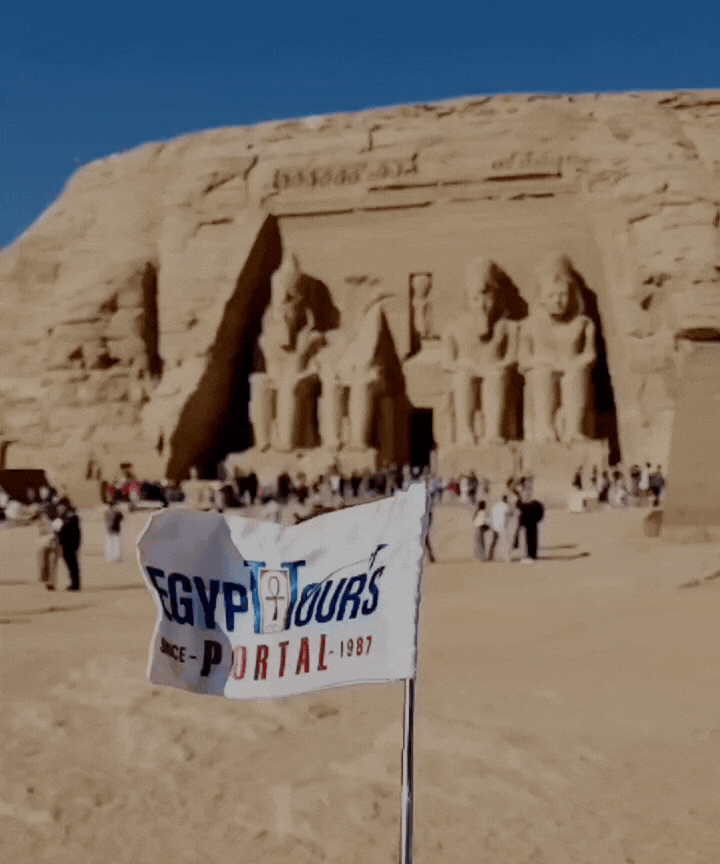
The Gold of Ancient Egypt provides a magical glimpse into the Eternal Brilliance of the ancient Egyptian civilization. the sun's golden rays have fused with the ancient Egyptian gold to shed light on the fabric of life that symbolizes divinity, power, and eternity. The gold of Ancient Egypt is a pure symbol of beauty, mastery, and mythology that converge in one timeless glow. gold was more than a treasure as it was known as the "flesh of the gods," the essence of immortality, and the cornerstone of a civilization that thrived for millennia.
From the shimmering sands of Nubia to the grand temples of Karnak and the tombs of pharaohs, gold adorned the living, sanctified the dead, and bridged the mortal with the divine. Everyone will step back into a world where every glimmer of gold holds a story, a purpose, and a profound spiritual meaning. Discover how this radiant metal became the lifeblood of a kingdom, the secret to its wealth, and a legacy that still dazzles the modern world.
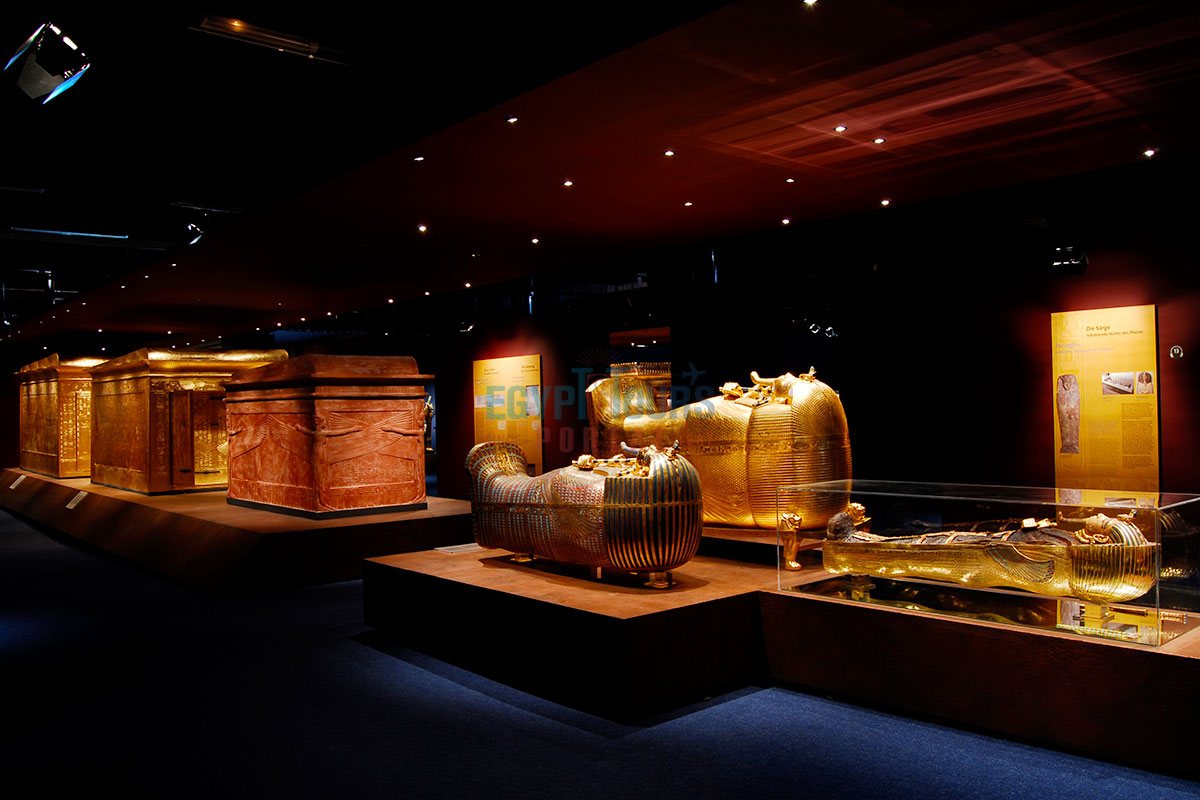
Gold (nebu in Ancient Egyptian) was a cornerstone of Ancient Egyptian civilization, symbolizing divine power, eternity, and supreme wealth. Revered for its indestructibility, brilliance, and resemblance to the sun, gold was associated with many Ancient Egyptian Gods and Goddesses like the sun god Ra, the giver of life and light. This connection made gold a physical manifestation of immortality and the gods’ flesh. Its symbolism was so integral that pharaohs, seen as divine intermediaries, adorned themselves and their surroundings with gold to assert their heavenly authority.
The use of gold dates back to at least 3000 BCE, with gold artifacts discovered in the tombs of the First Dynasty at Abydos. By the New Kingdom (1550–1070 BCE), Egypt’s golden age, gold became synonymous with power and divine favor. Titles like the "Golden Horus" emphasized the Pharaoh's connection to the gods. Royal treasuries hoarded vast quantities of gold, which was not just a measure of wealth but a vital diplomatic tool. For instance, gold tributes were exchanged with foreign rulers, such as the Mitanni king Tushratta, who described Egyptian gold as "more plentiful than dust."
Ancient Egyptian Temples and Tombs glistened with gilded statues, inscriptions, and ceremonial objects, embodying the belief that gold could bridge the mortal and divine worlds. Economically, gold enabled Egypt’s dominance in trade, connecting the Nile Valley with regions as distant as Mesopotamia and the Aegean.

Gold was inseparable from funerary practices, reflecting their belief in the eternal Afterlife of Ancient Egypt. The deceased, particularly the pharaohs and nobility, were equipped with gold to ensure protection and favor in the journey to the underworld. Tombs were filled with gilded artifacts, gold jewelry, and funerary items to aid the deceased in reaching the afterlife and achieving divine status.
The burial mask of Tutankhamun, crafted around 1323 BCE during the 18th Dynasty, epitomizes this tradition. Weighing over 10 kilograms (22 pounds), the mask features inscriptions invoking protection spells and serves as a bridge between the deceased and the gods. Coffins and sarcophagi were often gilded or made entirely of gold to signify the deceased's transformation into a divine being. For example, the solid gold innermost coffin of Tutankhamun weighs 110 kilograms (243 pounds) and represents unparalleled craftsmanship.
Gold amulets, such as scarabs and the ankh, were placed within the mummy wrappings to protect the body and ensure vitality in the afterlife. Temples and tombs of the wealthy featured golden offerings and treasures to please the gods and reflect the deceased's piety and status. Even golden sandals, found in Tutankhamun’s tomb, symbolized the king's divine journey through the underworld.
Explore more magnificent details about the rituals, beliefs, and customs of the religion of the ancient Egyptians.
Read More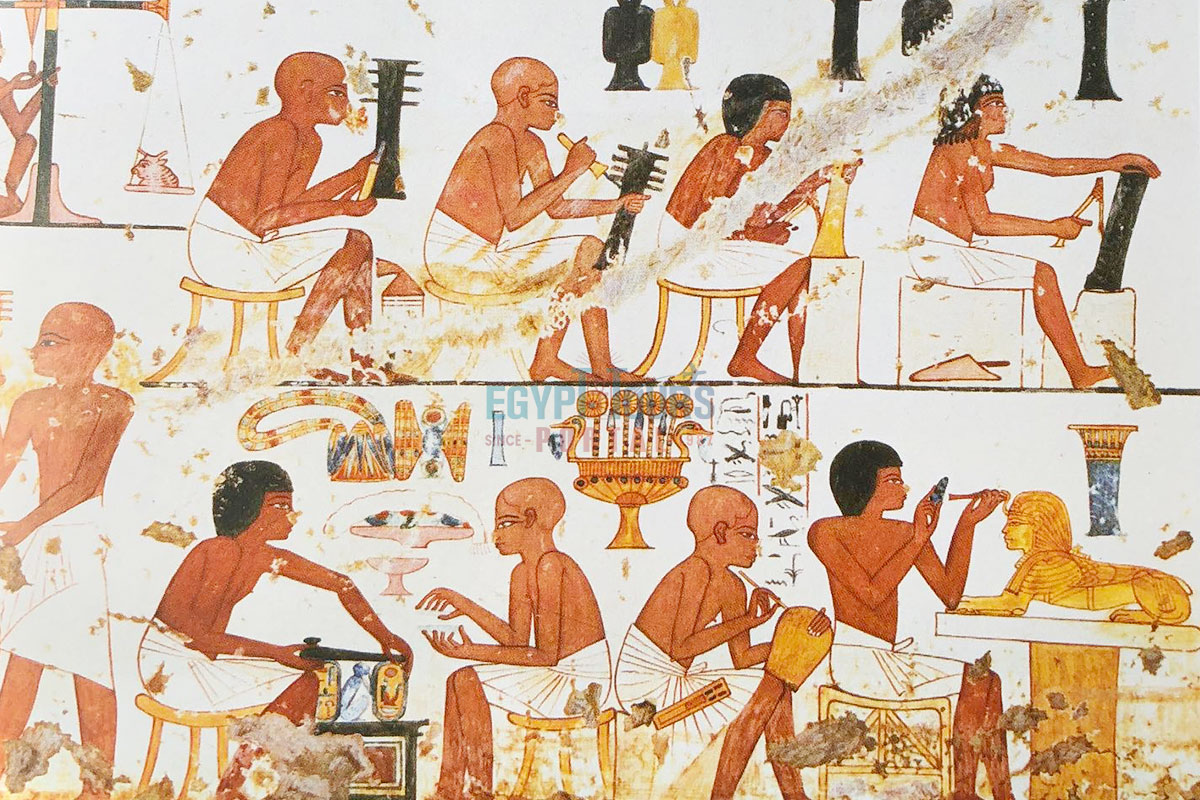
Ancient Egyptian Craftsmen and goldsmiths mastered various techniques that allowed them to create some of the most exquisite artifacts in the ancient world. These techniques included hammering gold into thin sheets, casting objects using the lost-wax method, and employing granulation and cloisonné techniques for intricate designs. Evidence of goldsmithing as early as 2600 BCE comes from the gilded artifacts in the tomb of Queen Hetepheres, mother of King Khufu, builder of the Great Pyramid Of Giza.
By the time of the New Kingdom, goldsmiths had perfected these methods. Hammering, one of the oldest techniques involved creating gold sheets as thin as one micron. These were used for gilding objects, such as the wooden shrine of Tutankhamun, which featured gold leaf applied over a plaster base. The lost-wax method allowed for precise casting of small figurines, like a solid gold statuette of Tutankhamun, only 5 cm (2 inches) tall.
Granulation involved attaching tiny gold spheres to create detailed textures, while cloisonné used thin strips of gold to form compartments for inlays of faience, glass, or semi-precious stones. These techniques were employed to craft elaborate jewelry, including necklaces, bracelets, and pectorals, such as those found in the tomb of Sithathoryunet, a Middle Kingdom princess, dated to around 1875 BCE.
Goldsmiths relied on charcoal-fired furnaces and foot-operated bellows for melting gold. Blowpipes allowed precise heat application, enabling detailed work on intricate pieces. These methods reveal the sophistication and creativity of Ancient Egyptian goldsmiths, whose work remains unparalleled.
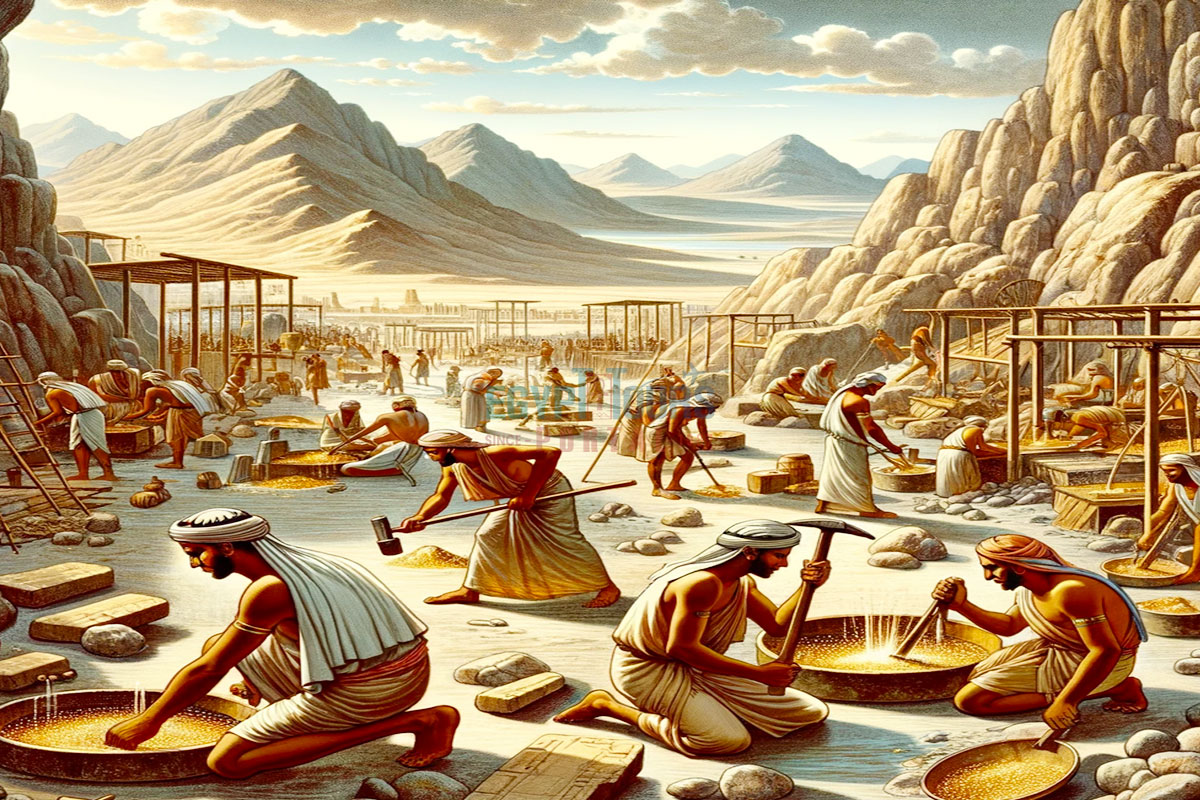
Egypt’s wealth in gold stemmed from the mineral-rich Eastern Desert and Nubia, regions exploited for their abundant deposits. Mining operations date back to the Pre-Dynastic Period (before 3100 BCE) and continued throughout Egypt’s history. Nubia, known as "the Land of Gold" (Ta-Sety), was particularly significant, providing the majority of Egypt’s gold resources.
Mining methods were labor-intensive and ingenious. Fire-setting, a process where fires were lit to crack rocks, was used to break quartz veins. Workers then manually crushed the ore using stone hammers and ground it into powder with mortars. Alluvial deposits from dry riverbeds were washed to separate gold particles, often transported to the Nile for processing due to water scarcity in the desert.
The Wawat region, part of Nubia, was a principal source of gold, as documented in inscriptions from the New Kingdom. Gold was often transported as hollow rings, making it easier to handle and store. Despite the lack of refining techniques, the Egyptians’ resourcefulness ensured a steady supply of gold, consolidating their economic and cultural dominance.
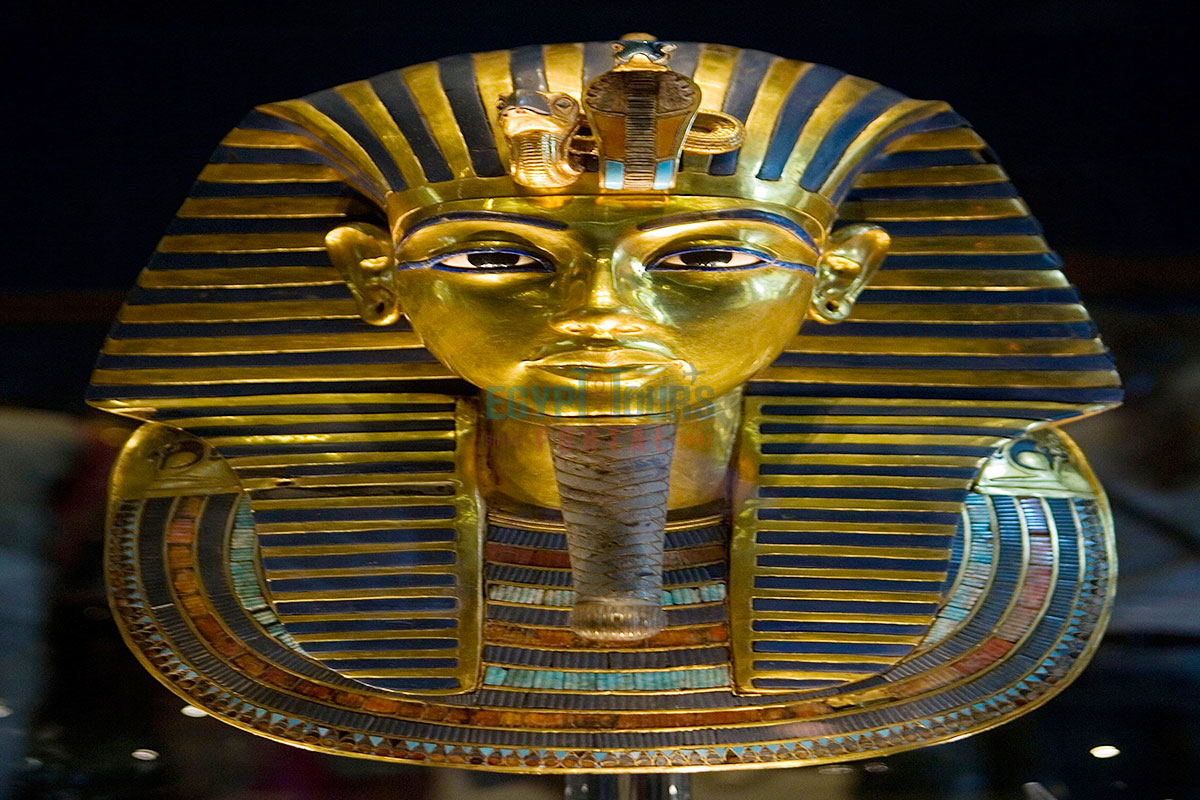
The golden death mask of Tutankhamun, created in 1323 BCE during the 18th Dynasty, remains one of the most iconic symbols of Ancient Egyptian Art and religious devotion. This masterpiece, discovered by Howard Carter in 1922 within the nearly intact tomb of the boy king, is composed of over 10 kilograms (24 pounds) of solid gold, adorned with inlays of lapis lazuli, carnelian, turquoise, obsidian, and quartz. Measuring 54 cm (21 inches) in height, the mask radiates the divine brilliance associated with the gods.
The mask’s idealized facial features including almond-shaped eyes, arched eyebrows, and a serene expression reflect the Egyptians' artistic conventions for depicting deities. The blue and gold nemes headdress, framed by stripes of lapis lazuli, symbolizes royalty, while the vulture and cobra emblems on the forehead represent the Unification of Upper and Lower Egypt. These Egyptian Symbols also align with the protection of Nekhbet and Wadjet, goddesses who safeguarded the pharaoh.
On the reverse side, inscriptions from the Book of the Dead are etched in hieroglyphs, invoking spells to protect the king’s body and guide his ka (spirit) to the afterlife. These inscriptions emphasize the Egyptians' meticulous attention to detail and their deep-seated belief in the transformative power of gold to secure immortality.
The mask exemplifies the advanced techniques employed by Egyptian goldsmiths. The hammering and inlaying methods allowed for intricate detailing, while the polished gold surface captured the light, creating an ethereal glow. This artifact, part of a vast treasure of over 5,000 objects in the tomb, demonstrates the 18th Dynasty's cultural zenith and reverence for gold as a divine material.
Explore the unique and magnificent discovery of the Tomb of Tutankhamun
Read More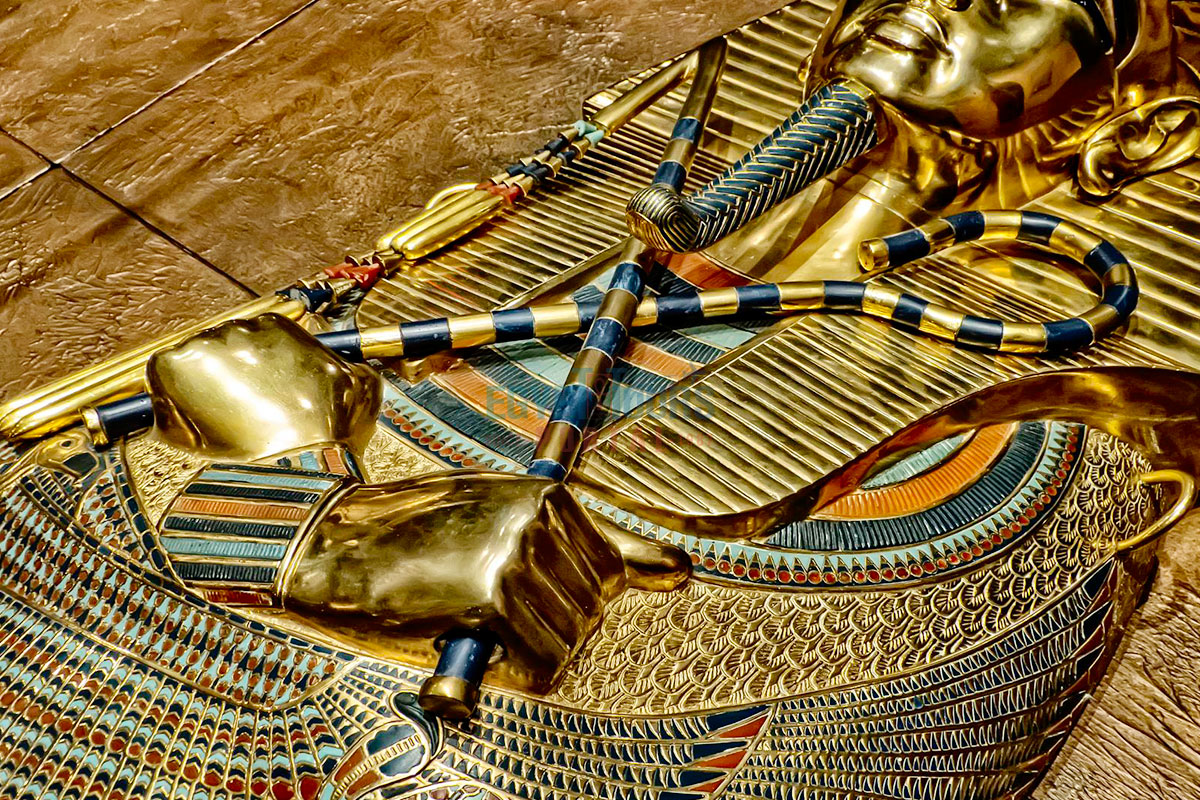
Pharaohs utilized gold as an ornament and a tool to assert their divine authority and symbolize their eternal connection with the gods. Gold, regarded as the "flesh of the gods," adorned every aspect of royal life, from regalia to architecture, reinforcing the pharaoh's role as a living deity and ruler. Golden crowns, including the Khepresh (blue crown), were symbols of military and divine power, often gilded or embedded with precious stones. Scepters and flails, such as the crook and flail symbolizing the king's role as shepherd and provider, were frequently embellished with gold to emphasize their sacred nature.
One of the most remarkable examples is the Golden Throne of Tutankhamun, a masterpiece inlaid with semi-precious stones, colored glass, and gold. Depicting the young king seated beside his wife, Ankhesenamun, the throne showcases the intimate yet divine connection between the royal couple. Temples and palaces prominently displayed gold treasures, including statues, ceremonial vessels, and furnishings, to emphasize the ruler’s wealth and piety.
Titles such as "The Golden Horus" highlighted the pharaoh’s divine protection and cosmic role. The inclusion of vast quantities of gold in royal tombs further symbolized the ruler's unending reign in the afterlife. This lavish use of gold projected Egypt’s wealth and cultural supremacy to both domestic subjects and foreign allies, establishing the pharaoh’s position as a divinely sanctioned ruler.

Gold was integral to the Economy of Ancient Egypt, functioning as a symbol of wealth and a tool for international diplomacy. As early as the Old Kingdom (2686–2181 BCE), Egypt’s wealth in gold was used to fund monumental construction projects, including the pyramids. By the New Kingdom, gold became a cornerstone of Egypt’s expansive trade networks.
Tributes of gold, such as the "Gold of Kush" from Nubia, enriched the royal treasury and funded Egypt’s military campaigns and administrative infrastructure. Gold was also used to establish alliances; for example, the Amarna Letters (14th century BCE) document gifts of gold to foreign rulers as tokens of goodwill.
The introduction of gold coins during the 30th Dynasty (circa 380 BCE), such as the stater minted under Pharaoh Teos, marked a shift towards monetized trade. These coins, modeled after Persian darics, facilitated trade with Greek mercenaries and foreign powers, though the majority of Egypt’s economy remained reliant on bartering and commodity exchange.
Gold's concentration within the royal court and temples ensured its continued role as a symbol of divine and economic power. By controlling gold production and distribution, the pharaohs maintained their dominance over regional trade and reinforced their image as guardians of prosperity.
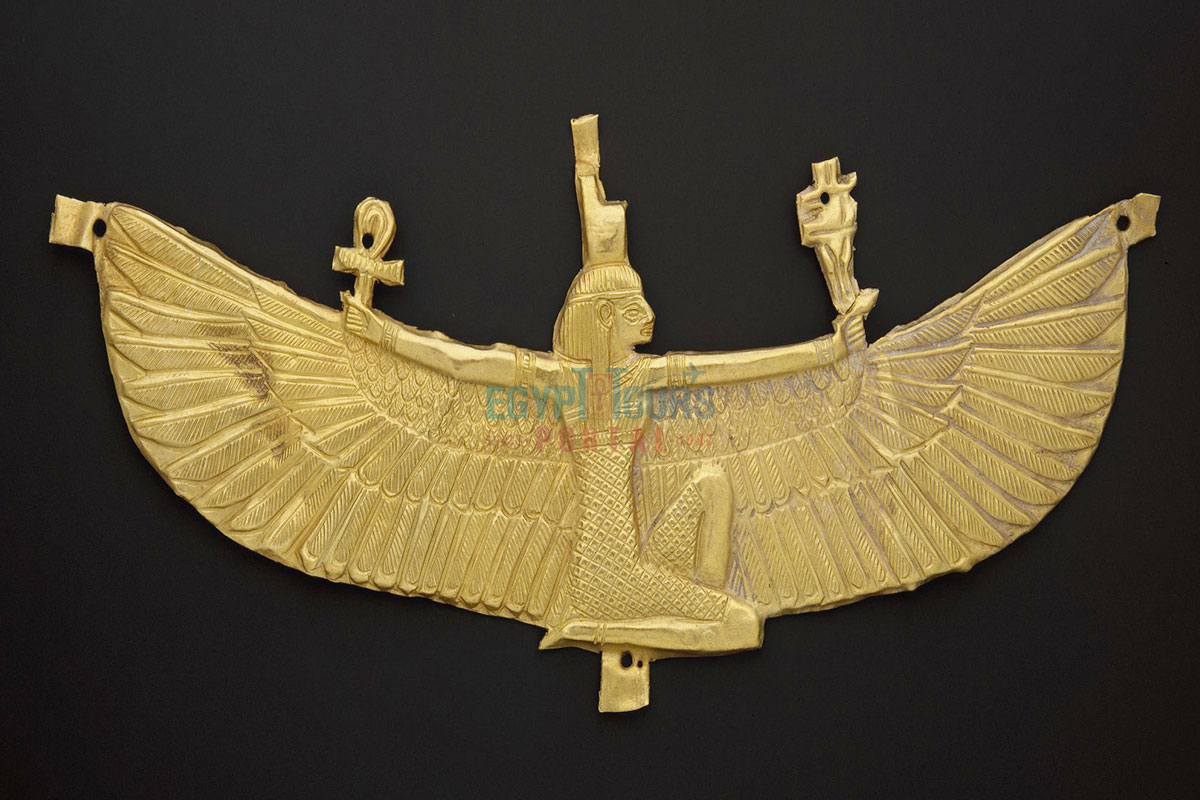
Gold’s divine association made it indispensable in Ancient Egyptian religious practices. Viewed as the gods’ incorruptible flesh, it symbolized immortality, purity, and eternal light. Statues of deities, often gilded or crafted entirely from gold, were central to temple rituals. For instance, the cult statue of Amun-Re in Karnak was reputedly gilded, reflecting the god’s radiant and eternal essence.
Gold was extensively used to create sacred objects, such as altars, ceremonial vessels, and offerings, which were presented in temples to honor the gods and secure their favor. The reflective properties of gold enhanced its symbolic role, creating an aura of divine presence in religious spaces.
Temple walls, inscribed with hieroglyphs and adorned with gold leaf, were designed to capture sunlight, reinforcing the connection between the gods and the celestial realm. Gold’s association with Ra, the sun god, ensured its prominence in rituals and iconography, symbolizing the cycle of life, death, and rebirth.
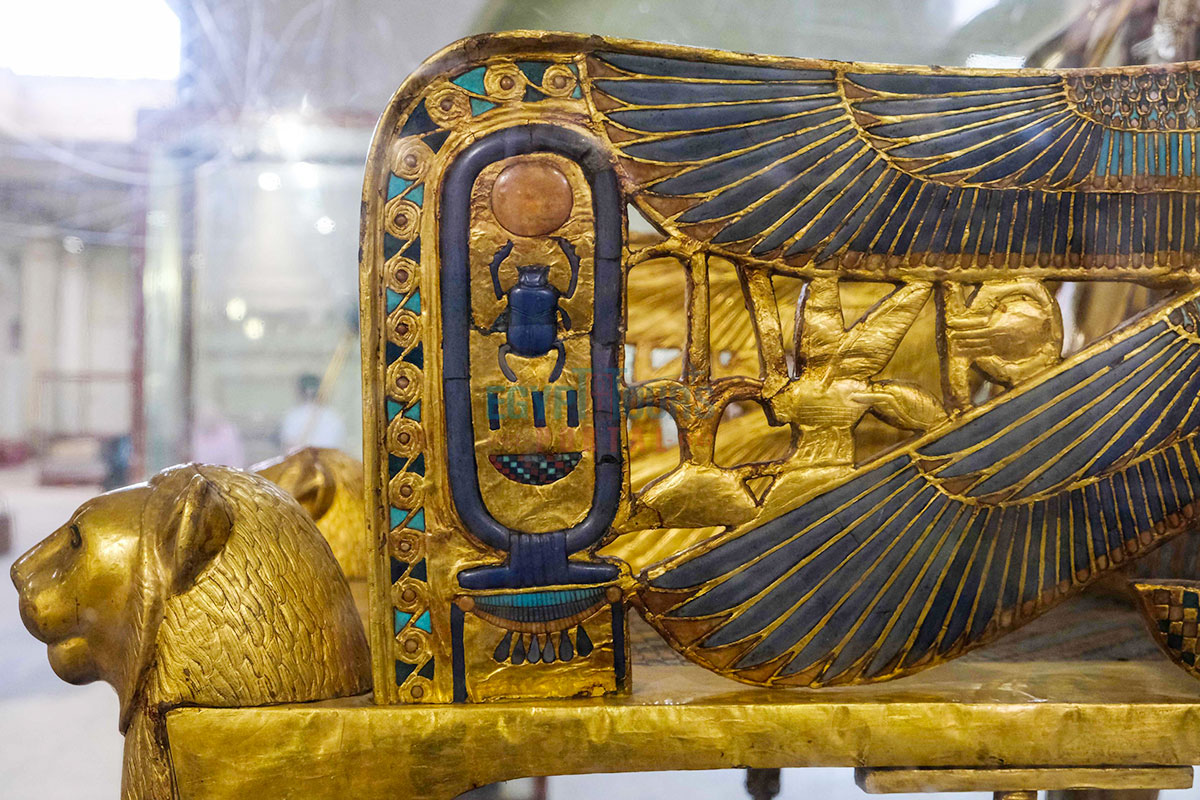
Gold’s symbolic and visual appeal made it a cornerstone of Egyptian art. Artists used gold to highlight the eternal and divine qualities of their subjects, whether in jewelry, statues, or any element of Ancient Egyptian Architecture. The gilding of tombs and temples served not only decorative purposes but also reinforced the belief in the eternal journey of the soul.
One notable example is the use of gold leaf in the tomb of Seti I (19th Dynasty), where gilded inscriptions and motifs accentuate the pharaoh’s divine status. Jewelry, such as pectorals and amulets, combined gold with colored stones to create pieces that were both protective and aesthetically stunning.
Gold was also used in paintings, with gilded details applied to scenes on papyri and wooden panels. These elements enhanced the artwork’s spiritual resonance, linking it to the divine realm.
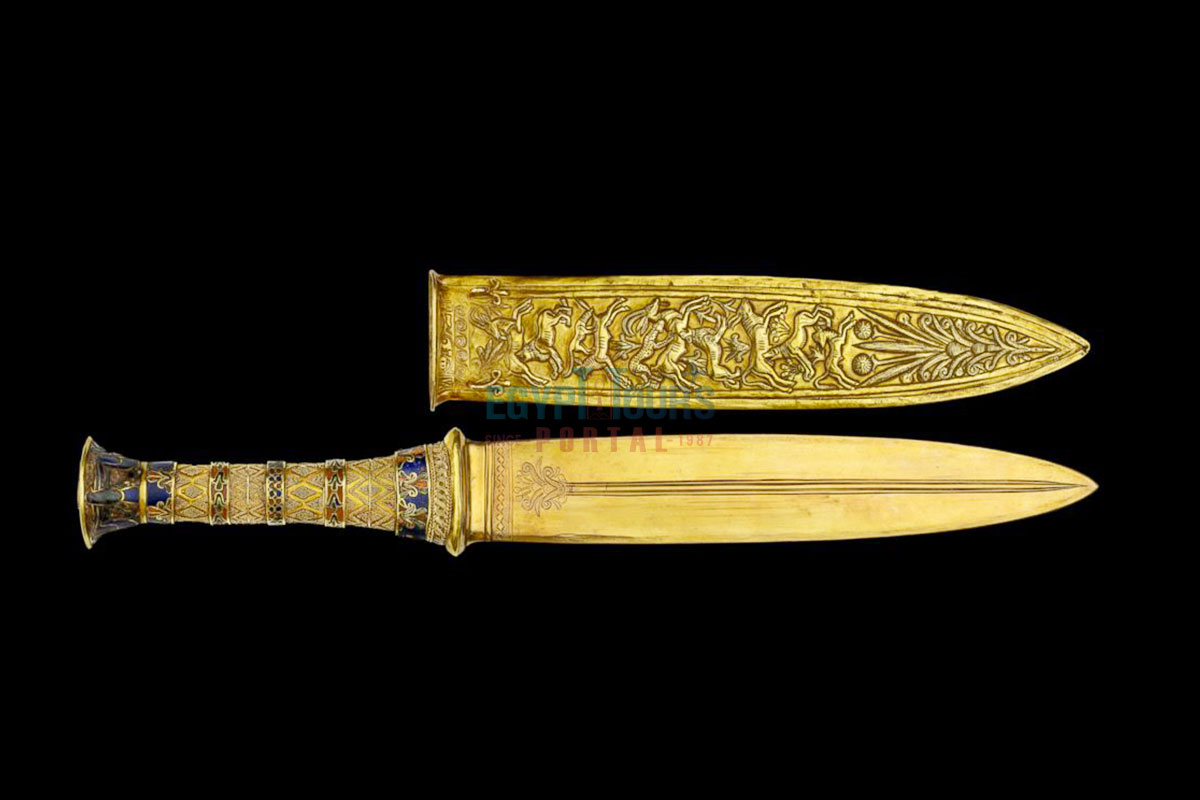
Egypt’s golden age began to wane after the New Kingdom (circa 1070 BCE), as political instability and foreign invasions disrupted access to gold-rich regions like Nubia. The weakening of central authority during the Third Intermediate Period (1070–664 BCE) further reduced the state’s control over gold production.
Foreign powers, including the Assyrians and Persians, exploited Egypt’s gold resources, while the Romans later repurposed much of it to finance their empire. By the Greco-Roman period (332 BCE onward), the lavish use of gold in temples and tombs diminished, reflecting a shift in its availability and symbolic role.
Despite these challenges, the legacy of Egypt’s golden era continued to inspire future civilizations, cementing its reputation as a land of unparalleled wealth and artistic achievement. The treasures of Tutankhamun, preserved through millennia, remain a testament to the enduring splendor of gold in Ancient Egypt.
The ancient Egyptians' use of gold was deeply symbolic, transcending mere wealth to embody divinity, immortality, and cosmic power. Gold in Egypt served not only as a material resource but also as a sacred symbol woven into the fabric of life, death, and the afterlife. From royal regalia to funerary objects, gold was a key element of Egyptian culture and religion, connecting the mortal realm to the divine.
The craftsmanship of Egyptian goldsmiths and the strategic importance of gold in Egypt’s economy and diplomacy further solidified its central role in the civilization’s power and legacy. As the “flesh of the gods,” gold was both a spiritual and economic tool that supported Egypt’s supremacy for millennia. By enjoying one of our epic Egypt tour packages from USA or one-of-a-kind Nile River Cruises, everyone will get to cast their eyes on the golden and radiant treasures of this immortal civilization found in all the eternal destinations of Egypt.
Private 4 Days Cairo Tour Packages for American Travelers 4 days Cairo Egypt Tour pa...
Tour Location: Cairo – Giza...
5 Days Cairo and Alexandria Tour Package For American Travelers 5 days Cairo and Ale...
Tour Location: Cairo/Giza/Alexandria...
6 Days Cairo, Luxor & Aswan Tour Package For American Travelers 6 days Cairo, Lu...
Tour Location: Cairo/Giza/Aswan/Luxor...
Amazing 7 Days Cairo and Hurghada Holiday for American Travelers 7 Days Cairo & ...
Tour Location: Cairo – Giza – Hurgh...
Gold was considered a symbol of divine power and immortality. It was associated with the gods, especially the sun god Ra, and was used to create treasures, royal ornaments, and funerary objects.
Ancient Egyptians mined gold in the Eastern Desert and Nubia. They used various tools, including hammers and fire, to extract and refine gold. Techniques for gold processing involved melting and casting gold into decorative objects and jewelry.
Gold played a key role in burial rituals, as it was believed to help the deceased achieve immortality. Items like golden death masks (Tutankhamun’s mask) and golden amulets were placed in tombs to ensure a safe passage to the afterlife.
No, gold was not used as currency in Ancient Egypt. Instead, it was a symbol of wealth, and divine power, and was used to craft jewelry and religious artifacts.
Some of the most famous gold artifacts include the golden mask of Tutankhamun, the treasures of the Valley of the Kings, and the golden coffins and jewelry of Egyptian royalty.
Gold mines were located primarily in the Eastern Desert, as well as in Nubia, where the Egyptians found rich deposits of gold. These mines contributed significantly to Egypt's wealth.
Gold was used to create intricate jewelry, amulets, and statues, often as offerings to the gods or as part of royal attire. It was also used in the creation of elaborate sarcophagi and tomb treasures.
Goldsmiths used various techniques such as casting, hammering, and gilding to create jewelry and decorative items. They were skilled in melting and molding gold into complex shapes and designs.
Gold was seen as a symbol of the god's power and the eternal life that awaited the righteous in the afterlife. It was believed to help the deceased in their journey to the next world and ensure their immortality.
The Egyptians' goldworking techniques and designs influenced later cultures, particularly in the Mediterranean and Near East, where Egyptian art and craftsmanship were admired and imitated.
The entire country of Egypt deserve to be explored with its every heavenly detail but there are places that must be seen before any other such as the breathtaking Hurghada's red sea, The wonders of Cairo the pyramids of Giza, the great sphinx, the Egyptian Museum, Khan El Khalili Bazaar, the wonders of Luxor like Valley of the Kings, Karnak & Hatshepsut temple and the wonders of Aswan such as Abu Simbel temples, Philea temple, Unfinished obelisk and The Wonders of Alexandria like Qaitbat Citadel, Pompey's Pillar and Alexandria Library. Read more about the best places to visit in Egypt.
If you want to apply for a Visa On Arrival that lasts for 30 days then you should be one of the eligible countries, have a valid passport with at least 6 months remaining and pay 25$ USD in cash, as for the E-Visa for 30 day you should have a valid passport for at least 8 months, complete the online application, pay the e-visa fee then print the e-visa to later be presented to the airport border guard. You could also be one of the lucky ones who can obtain a free visa for 90 days. Read more about Egypt travel visa.
Egypt has a variety of delicious cuisines but we recommend “Ful & Ta’meya (Fava Beans and Falafel)”, Mulukhiya, “Koshary”, a traditional Egyptian pasta dish, and Kebab & Kofta, the Egyptian traditional meat dish.
The best time to travel to Egypt is during the winter from September to April as the climate becomes a little tropical accompanied by a magical atmosphere of warm weather with a winter breeze. You will be notified in the week of your trip if the Climate is unsafe and if any changes have been made.
You should pack everything you could ever need in a small bag so you could move easily between your destinations.
We have been creating the finest vacations for more than 20 years around the most majestic destinations in Egypt. Our staff consists of the best operators, guides and drivers who dedicate all of their time & effort to make you have the perfect vacation. All of our tours are customized by Travel, Financial & Time consultants to fit your every possible need during your vacation. It doesn't go without saying that your safety and comfort are our main priority and all of our resources will be directed to provide the finest atmosphere until you return home.
You will feel safe in Egypt as the current atmosphere of the country is quite peaceful after the government took powerful measures like restructuring the entire tourist police to include all the important and tourist attractions in Egypt. Read more about is it safe to travel to Egypt.
Wear whatever feels right and comfortable. It is advised to wear something light and comfortable footwear like a closed-toe shoe to sustain the terrain of Egypt. Put on sun block during your time in Egypt in the summer to protect yourself from the sun.
The best activity is by far boarding a Nile Cruise between Luxor and Aswan or Vise Versa. Witness the beauty of Egypt from a hot balloon or a plane and try all the delicious Egyptian cuisines and drinks plus shopping in old Cairo. Explore the allure and wonders of the red sea in the magical city resorts of Egypt like Hurghada and many more by diving and snorkeling in the marine life or Hurghada. Behold the mesmerizing western desert by a safari trip under the heavenly Egyptian skies.
There are a lot of public holidays in Egypt too many to count either religious or nation, the most important festivals are the holy month of Ramadan which ends with Eid Al Fitr, Christmas and new years eve. Read more about festivals & publich holidays in Egypt.
Egypt is considered to be one of the most liberal Islamic countries but it has become a little bit conservative in the last couple of decades so it is advised to avoid showing your chest, shoulders or legs below the knees.
Arabic is the official language and Most Egyptians, who live in the cities, speak or understand English or at least some English words or phrases. Fewer Egyptians can speak French, Italian, Spanish, and German. Professional tour guides, who work in the tourism sector, are equipped to handle visitors who cannot speak Arabic and they will speak enough English and other languages to fulfill the needs of all our clients.
The fastest way is a car, of course, a taxi. If you are in Cairo ride a white taxi to move faster or you could board the fastest way of transportation in Egypt metro if the roads are in rush hour.
The temperature in Egypt ranges from 37c to 14 c. Summer in Egypt is somehow hot but sometimes it becomes cold at night and winter is cool and mild. The average of low temperatures vary from 9.5 °C in the wintertime to 23 °C in the summertime and the average high temperatures vary from 17 °C in the wintertime to 32 °C in the summertime. The temperature is moderate all along the coasts.
It is the home of everything a traveler might be looking for from amazing historical sites dating to more than 4000 years to enchanting city resorts & beaches. You will live the vacation you deserve as Egypt has everything you could possibly imagine.









